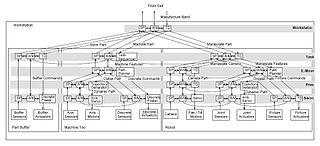Related Research Articles
The Knowledge Query and Manipulation Language, or KQML, is a language and protocol for communication among software agents and knowledge-based systems. It was developed in the early 1990s as part of the DARPA knowledge Sharing Effort, which was aimed at developing techniques for building large-scale knowledge bases which are shareable and reusable. While originally conceived of as an interface to knowledge based systems, it was soon repurposed as an Agent communication language.
In computing, cross-platform software is computer software that is designed to work in several computing platforms. Some cross-platform software requires a separate build for each platform, but some can be directly run on any platform without special preparation, being written in an interpreted language or compiled to portable bytecode for which the interpreters or run-time packages are common or standard components of all supported platforms.
Distributed Artificial Intelligence (DAI) also called Decentralized Artificial Intelligence is a subfield of artificial intelligence research dedicated to the development of distributed solutions for problems. DAI is closely related to and a predecessor of the field of multi-agent systems.
In computer science, a software agent is a computer program that acts for a user or another program in a relationship of agency.
In computer science, a mobile agent is a piece of software agent combined with data that is able to migrate from one computer to another autonomously and continue its execution on the destination with the ability to interact with other agents there. Rather than a client requesting data and performing actions, a mobile agent is sent to a server to perform those tasks. This paradigm delegates the work from the client and onto the server.

A multi-agent system is a computerized system composed of multiple interacting intelligent agents. Multi-agent systems can solve problems that are difficult or impossible for an individual agent or a monolithic system to solve. Intelligence may include methodic, functional, procedural approaches, algorithmic search or reinforcement learning.
The belief–desire–intention software model (BDI) is a software model developed for programming intelligent agents. Superficially characterized by the implementation of an agent's beliefs, desires and intentions, it actually uses these concepts to solve a particular problem in agent programming. In essence, it provides a mechanism for separating the activity of selecting a plan from the execution of currently active plans. Consequently, BDI agents are able to balance the time spent on deliberating about plans and executing those plans. A third activity, creating the plans in the first place (planning), is not within the scope of the model, and is left to the system designer and programmer.
Agent Communication Language (ACL), proposed by the Foundation for Intelligent Physical Agents (FIPA), is a proposed standard language for agent communications. Knowledge Query and Manipulation Language (KQML) is another proposed standard.
Java Agent Development Framework, or JADE, is a software framework for the development of software agents, implemented in Java. JADE system supports coordination between several agents FIPA and provides a standard implementation of the communication language FIPA-ACL, which facilitates the communication between agents and allows the services detection of the system. JADE was originally developed by Telecom Italia and is distributed as free software.
Web-based simulation (WBS) is the invocation of computer simulation services over the World Wide Web, specifically through a web browser. Increasingly, the web is being looked upon as an environment for providing modeling and simulation applications, and as such, is an emerging area of investigation within the simulation community.
JACK Intelligent Agents is a framework in Java for multi-agent system development. JACK Intelligent Agents was built by Agent Oriented Software Pty. Ltd. (AOS) and is a third generation agent platform building on the experiences of the Procedural Reasoning System (PRS) and Distributed Multi-Agent Reasoning System (dMARS). JACK is one of the few multi-agent systems that uses the BDI software model and provides its own Java-based plan language and graphical planning tools.

Real-time Control System (RCS) is a reference model architecture, suitable for many software-intensive, real-time computing control problem domains. It defines the types of functions needed in a real-time intelligent control system, and how these functions relate to each other.
The Contract Net Protocol (CNP) is a task-sharing protocol in multi-agent systems, introduced in 1980 by Reid G. Smith. It is used to allocate tasks among autonomous agents. It is close to sealed auctions protocols. It mainly relies on the Subcontractor: a manager proposes a task to several agents. The latter make a proposal among which the manager chooses to allocate the task. This task can then be divided and subcontracted.
Agent-oriented programming (AOP) is a programming paradigm where the construction of the software is centered on the concept of software agents. In contrast to object-oriented programming which has objects at its core, AOP has externally specified agents at its core. They can be thought of as abstractions of objects. Exchanged messages are interpreted by receiving "agents", in a way specific to its class of agents.
2APL is a modular BDI-based programming language that supports the development of multi-agent systems. 2APL provides a rich set of programming constructs allowing direct implementation of concepts such as beliefs, declarative goals, actions, plans, events, and reasoning rules. The reasoning rules allow run-time selection and generation of plans based on declarative goals, received events and messages, and failed plans. 2APL can be used to implement muti-agent systems consisting of software agents with reactive as well as pro-active behaviours.

Juan Pavón is a Spanish computer scientist, full professor of the Complutense University of Madrid (UCM). He is a pioneer researcher in the field of Software Agents, co-creator of the FIPA MESSAGE and INGENIAS methodologies, and founder and director of the research group GRASIA: GRoup of Agent-based, Social and Interdisciplinary Applications at UCM. He is known for his work in the field of Artificial Intelligence, specifically in agent-oriented software engineering. He has been often cited by mainstream media, as a reference in Artificial Intelligence.
The SARL programming language is a modular agent-oriented programming language. It aims at providing the fundamental abstractions for dealing with concurrency, distribution, interaction, decentralization, reactivity, autonomy and dynamic reconfiguration.
Agent mining is an interdisciplinary area that synergizes multiagent systems with data mining and machine learning.
References
- ↑ Poslad, S. (2007). "Specifying Protocols for Multi-agent System Interaction". ACM Transactions on Autonomous and Adaptive Systems. 2 (4): 15–es. doi:10.1145/1293731.1293735. S2CID 9477595.
- ↑ Bellifeminee, Fabio; Agostino Poggi; Giovanni Rimassa (2001). JADE: a FIPA2000 compliant agent development environment. Proceedings of the fifth international conference on Autonomous agents. pp. 216–217.
- ↑ McCabe, Frank G.; Keith L. Clark (1995). April—agent process interaction language, In: Intelligent Agents. Springer Berlin Heidelberg. pp. 324–340.
- ↑ Nwana, Hyacinth; Divine T. Ndumu; Lyndon C. Lee; Jaron C. Collis (1999). ZEUS: a toolkit and approach for building distributed multi-agent systems. AGENTS '99: Proceedings of the third annual conference on Autonomous Agents. pp. 360–361.
- ↑ Poslad, S.; P. Buckle; R. Hadingham (2000). The FIPA-OS agent platform: Open Source for Open Standards. Proceedings of 5th Int. Conf on the Practical Application of Intelligent Agents and Multi-Agent Technology (PAAM), Manchester, UK. pp. 355–368.,
- ↑ Poslad, S.; Buckle, P.; Hadingham, R.G (2001). "Open Source, Standards and Scaleable Agencies". Infrastructure for Agents, Multi-Agent Systems, and Scalable Multi-Agent Systems. Lecture Notes in Computer Science. Vol. 1887. pp. 296–303. doi:10.1007/3-540-47772-1_30. ISBN 978-3-540-42315-7.